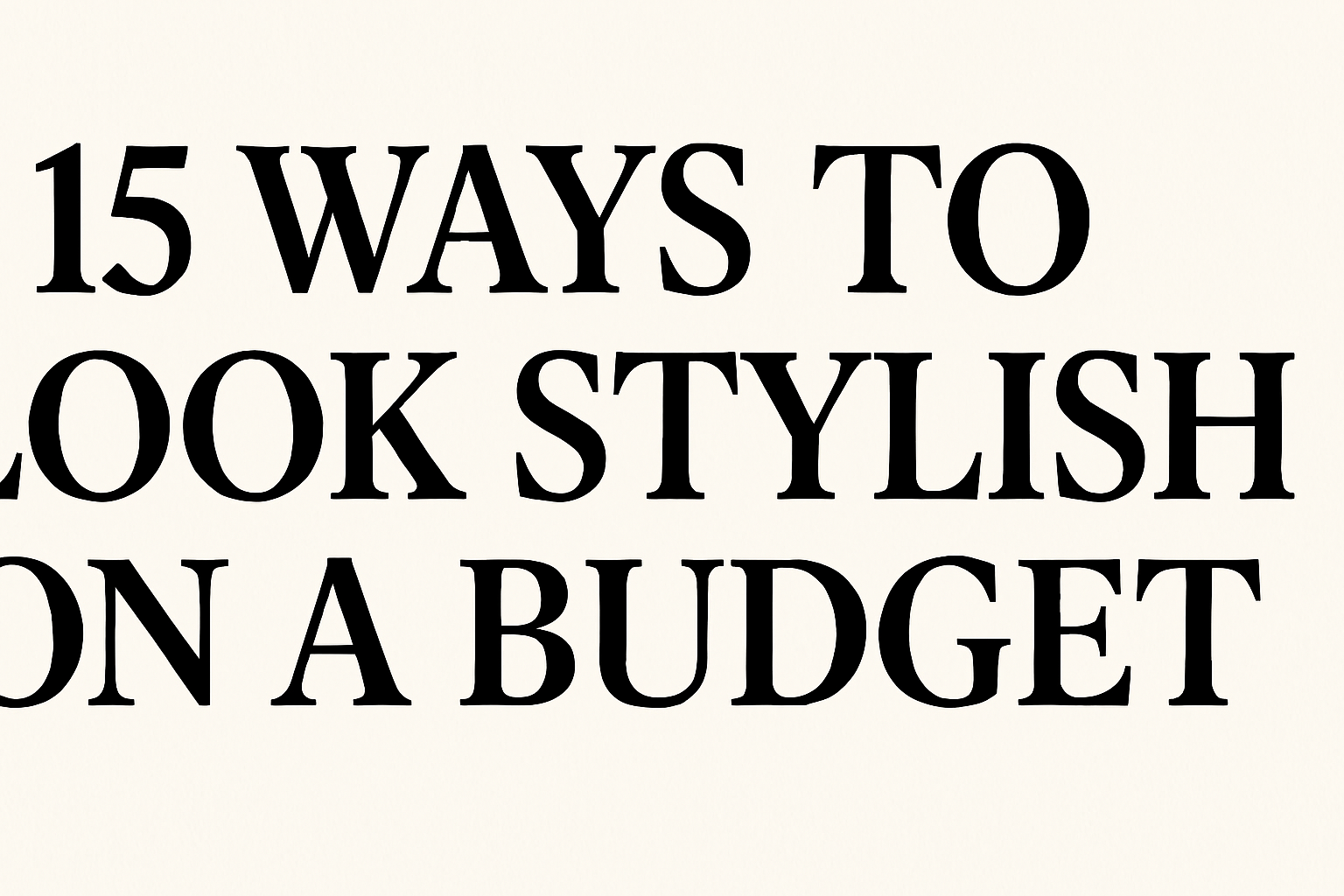15 ways to look stylish on a budget
Introduction
Looking stylish doesn’t require a big bank account—it requires clarity, consistency, and a few smart habits. If you’ve ever felt overwhelmed by trends or frustrated by impulse buys, this guide will help you build a wardrobe you actually wear and love, without overspending.
What “look stylish on a budget” really means
- Style over spend: Focus on fit, versatility, and personal taste—not labels or price tags.
- Consistency beats quantity: A small set of well-chosen pieces creates more outfits than a crowded closet.
- Intentional shopping: Every purchase must earn its place through cost-per-wear and mix-and-match potential.
15 proven ways to look stylish on a budget
- Build a capsule wardrobe
- Start with 20–30 mixable essentials in neutral tones (black, navy, white, grey, beige).
- Add 2–4 pieces in your signature color to keep things personal.
- Prioritize fit (your #1 style multiplier)
- Hem pants, taper sleeves, and adjust waistlines for clean lines.
- If tailoring isn’t an option, choose brands whose cuts match your body type.
- Thrift and consignment smartly
- Shop neighborhoods with good turnover; scan fabrics first (wool, cotton, linen, denim).
- Check seams, zippers, and underarms for wear before buying.
- Shop off-season and stack discounts
- Buy coats in late winter, swimwear in late summer.”fashion trends 2025″
- Combine sale + coupon + loyalty points; add items to a price-watch list.
- Use cost-per-wear to decide
- Choose a blazer for 100 wears over a sequined top for 2. Lower cost-per-wear wins.
- Aim for pieces you can style 3 ways before buying.
- Master outfit formulas
- Examples: structured top + relaxed bottom + clean sneaker; tee + blazer + dark denim; midi skirt + knit + ankle boots.”budget fashion tips”
- Pick 2–3 formulas and repeat with variations.
- Accessorize with intention
- One statement (watch, belt, earrings) is enough—don’t compete for attention.
- A leather belt and minimalist jewelry instantly elevate basics.
- Care for your clothes
- Wash cold, air-dry, use a steamer, de-pill knits, rotate shoes to preserve shape.
- Proper care makes budget pieces look premium for longer.
- Invest in versatile footwear
- Choose 2–3 pairs that cover most outfits: clean white sneakers, classic loafers/ankle boots, dress shoes.
- Keep them polished; shoes set the tone of your look.
- Layer and play with proportion
- Long coat over slim base, cropped jacket over high-waist bottoms.
- The “rule of thirds” (1/3 top, 2/3 bottom or vice versa) flatters most bodies.
- Go monochrome or tonal
- Wearing one color family looks intentional and sleek—even with inexpensive pieces.
- Mix textures (knit, denim, leather) to add depth.
- Alter and upcycle
- Swap buttons, crop a tee, cuff jeans, dye faded blacks, add darts to boxy tops.
- Small tweaks = big style upgrades for pennies.
- Swap and borrow
- Host clothing exchanges with friends for “new” outfits at zero cost.
- Borrow occasion wear instead of buying for one-time events.
- Rent for special occasions
- For weddings/interviews/galas, renting prevents pricey, low-use purchases.
- Keep your core wardrobe timeless; rent trends occasionally.
- Grooming and posture
- Neat hair, trimmed nails, lint-free clothes, and upright posture outclass any label.
- A lint roller and fabric shaver are budget style essentials.
Apply process: put it into action in 7 days
- Day 1: Define your style
- Save 10–15 reference outfits. Note common colors, silhouettes, and vibes.
- Day 2: Closet edit
- Keep only items that fit, flatter, and match your style. Create donate/sell/alter piles.
- Day 3: Build your capsule
- List gaps (e.g., dark denim, white tee, black belt). Set a strict budget ceiling.
- Day 4: Fit first
- Measure yourself; try on your keepers; mark what needs simple alterations.
- Day 5: Smart sourcing
- Check thrift/consignment first, then sales. Use a price cap per item and cost-per-wear test.
- Day 6: Outfit formulas
- Create 6–10 outfits from your capsule. Photograph them for quick mornings.
- Day 7: Care routine
- Set up a laundry plan, shoe rotation, and a 10-minute weekly de-pill/steam session.
Important “documents” to keep (your budget-style toolkit)
- Measurements: Chest, waist, hips, shoulder, inseam, sleeve, and best-fitting garment measurements.
- Wardrobe checklist: Tops, bottoms, layers, shoes, accessories; mark gaps and duplicates.
- Budget & tracker: Monthly style budget, wish list with price caps, cost-per-wear notes.
- Outfit lookbook: Photos of your best outfits; a color palette swatch you actually wear.
- Care guide: Fabric care notes, stain-removal cheats, shoe care schedule.
- Deals folder: Coupons, store calendars (clearance cycles), return policies, and receipts.
Eligibility criteria (who this works for)
- Best for: Anyone who wants consistency, values fit over labels, and can commit to simple routines.
- Budget range: Works at any budget; you’ll prioritize high-impact basics first, then add accents.
- Time required: 2–3 hours for the initial edit; 10 minutes weekly for maintenance.
- Not ideal if: You only want new trends weekly, dislike repeats, or won’t tailor/maintain items at all.
Quick, high-impact starter list
- Buy now (budget-friendly): Crisp white tee, dark straight-leg jeans, black belt, neutral sneakers, simple studs or watch.
- Upgrade via care: De-pill knits, steam shirts, polish shoes.
- Style today: Monochrome outfit + one accessory + clean shoes.
Final note
Style isn’t about spending; it’s about editing. Choose fewer, better-fitting pieces, care for them well, and repeat what works. Your closet should serve your life—not the other way around.
